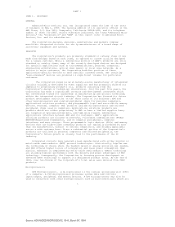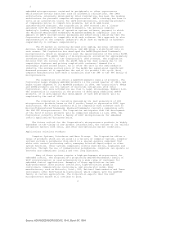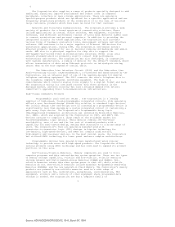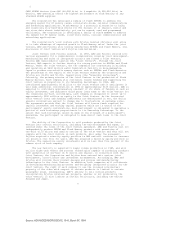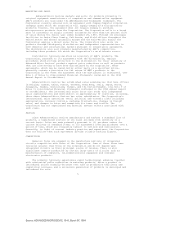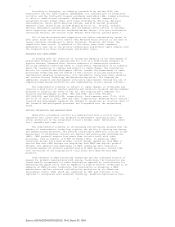AMD 1993 Annual Report Download - page 16
Download and view the complete annual report
Please find page 16 of the 1993 AMD annual report below. You can navigate through the pages in the report by either clicking on the pages listed below, or by using the keyword search tool below to find specific information within the annual report. 12
California Court of Appeal affirmed in all respects the Arbitrator's
determinations that Intel breached the 1982 Agreement, however, the Court of
Appeal held that the arbitrator exceeded his powers in awarding to AMD a license
to Intel intellectual property, if any, in AMD's Am386 microprocessor and in
extending the 1976 patent and copyright agreement between AMD and Intel (the
"1976 Agreement") by two years. As a result, the Court of Appeal ordered the
lower court to correct the award to remove these rights and then confirm the
award as so corrected.
On September 2, 1993, the California Supreme Court granted the
Corporation's petition for review of the California Court of Appeal decision
that the Arbitrator exceeded his authority. The Corporation has requested that
the California Supreme Court affirm the judgment confirming the Arbitrator's
award to the Corporation, which includes the right to the Intel 386 microcode.
If the California Supreme Court affirms the judgment confirming the
Arbitrator's award, the Corporation would assert an additional defense against
Intel's intellectual property claims in the 386 and 486 Microcode Litigations
(discussed below) which could preclude Intel from continuing to pursue any
damage or intellectual property claims regarding the Am386. If the Supreme Court
does not affirm the judgment it could: (i) decide to remand the matter for a new
Arbitration proceeding either on the merits or solely on the issue of relief
including the damages due to the Corporation, or (ii) order no further
proceedings which would foreclose the possibility of AMD collecting additional
monetary damages through the Arbitration and/or potentially impact AMD's ability
to use the Arbitration Award as a defense in the 386 or 486 Microcode
Litigations discussed below. The California Supreme Court is expected to decide
the case by the end of 1994.
The Corporation believes it has the right to use Intel technology to
manufacture and sell AMD's microprocessor products based on a variety of factors
including: (i) the 1982 Agreement, (ii) the Arbitrator's award in the
Arbitration which is pending review by the California Supreme Court and (iii)
the 1976 Agreement. An unfavorable decision by the California Supreme Court
could materially affect other AMD/Intel Microcode Litigations discussed herein.
The AMD/Intel Litigations involve multiple interrelated and complex issues of
fact and law. Therefore, the ultimate outcome of the AMD/Intel Litigations
cannot presently be determined. Accordingly, no provision for any liability that
may result upon the adjudication of the AMD/Intel Litigations has been made in
the Corporation's financial statements.
3. 287 Microcode Litigation. (Case No. C-90-20237, N. D. Cal.) On April
23, 1990, Intel Corporation filed an action against the Corporation in the U.S.
District Court, Northern District of California, seeking an injunction and
damages with respect to the Corporation's 80C287, a math coprocessor designed to
function with the 80286. Intel's suit alleges several causes of action,
including infringement of Intel copyright on the Intel microcode used in its 287
math coprocessor. In June 1992, a jury determined that the Corporation did not
have the right to use Intel microcode in the 80C287. On December 2, 1992, the
court denied the Corporation's request for declaratory relief to the effect it
has the right, under the 1976 Agreement with Intel to distribute products
containing Intel microcode. The Corporation filed a motion on February 1, 1993,
for a new trial based upon the discovery by AMD of evidence improperly withheld
by Intel at the time of trial.
In April, 1993, the court granted AMD a new trial on the issue of whether
the 1976 Agreement with Intel Corporation granted AMD a license to use Intel
microcode in its products. The ruling vacated both an earlier jury verdict
holding that the 1976 Agreement did not cover the rights to microcode contained
in the Intel 80287 math coprocessor and the December 2, 1992 ruling (discussed
above). A new trial commenced in January, 1994 and a decision is expected in
either the first or second quarter of 1994.
The impact of the ultimate outcome of the 287 Microcode Litigation is
highly uncertain and dependent upon the scope and breadth of the final decision
in the case. A decision of broad scope could not only result in a damages award
but also impact the Corporation's ability to continue to ship and produce its
Am486DX product or other microprocessor products adjudicated to contain any
copyrighted Intel microcode. The Corporation's inability to ship product could
have a material adverse impact on the Corporation's trends in results of
operations and financial condition. The outcome of the 287 litigation could also
materially impact the outcomes in the other AMD/Intel Microcode Litigations
discussed herein. The AMD/Intel Litigations involve multiple interrelated and
complex issues of fact and law. Therefore, the ultimate outcome of the AMD/Intel
Litigations cannot presently be determined. Accordingly, no provision for any
liability that may
11
Source: ADVANCED MICRO DEVIC, 10-K, March 07, 1994


